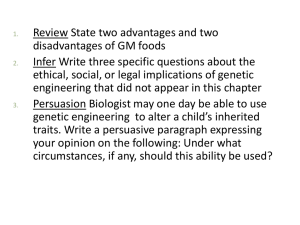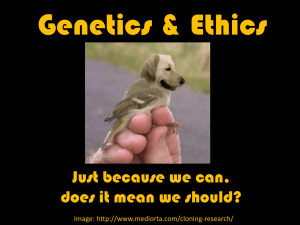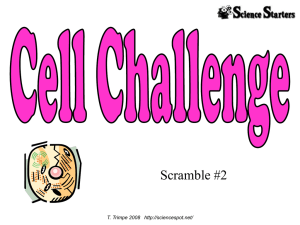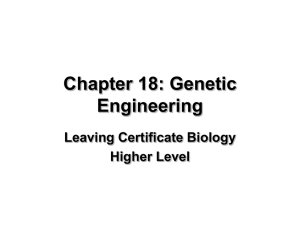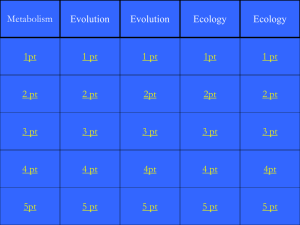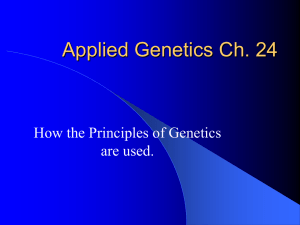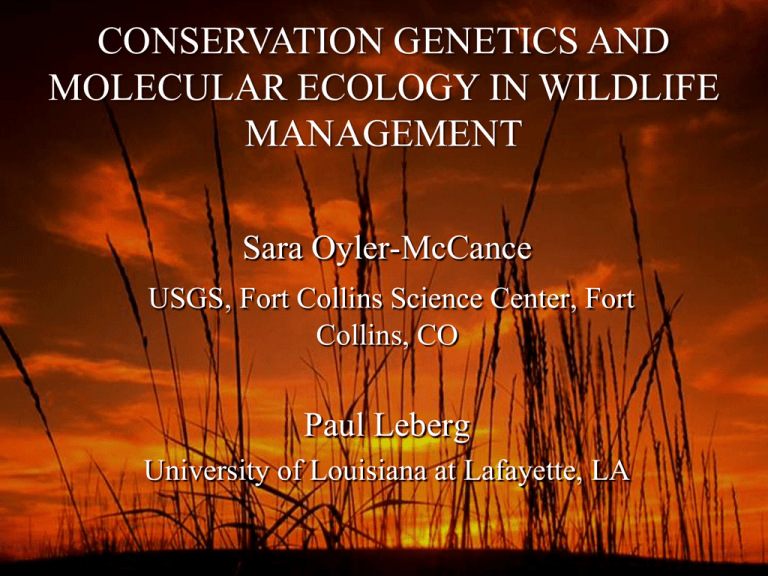
CONSERVATION GENETICS AND
MOLECULAR ECOLOGY IN WILDLIFE
MANAGEMENT
Sara Oyler-McCance
USGS, Fort Collins Science Center, Fort
Collins, CO
Paul Leberg
University of Louisiana at Lafayette, LA
Introduction
► Genetic
techniques have only recently been
applied to wildlife studies
► Due
to technological advances that have
made genetic methods straightforward and
inexpensive
Molecular Genetic Techniques
► All
techniques examine portions of DNA at some
scale
genome – biparentally inherited, found
in cell nucleus, evolves slowly (yet some regions
evolve rapidly)
► Nuclear
– maternally inherited,
housed in mitochondrion, much smaller than
nuclear genome, evolves quickly, well mapped in
many species
► Mitochondrial genome
Investigating Genetic Variation
► Some
techniques consider gene products (e.g.
proteins) while others examine variation at the
nucleotide level (e.g., DNA sequencing,
fragment analysis)
Reaction (PCR) – a region of
DNA is targeted and amplified exponentially
► Polymerase Chain
Polymerase Chain Reaction
Forward Primer
Reverse Primer
…………AGCTTAGCTATATG…………
AGCTTAGCTATATG
AGCTTAGCTATATG
AGCTTAGCTATATG
AGCTTAGCTATATG
AGCTTAGCTATATG
AGCTTAGCTATATG
AGCTTAGCTATATG
AGCTTAGCTATATG
AGCTTAGCTATATG
AGCTTAGCTATATG
AGCTTAGCTATATG
AGCTTAGCTATATG
AGCTTAGCTATATG
AGCTTAGCTATATG
AGCTTAGCTATATG
AGCTTAGCTATATG
AGCTTAGCTATATG
AGCTTAGCTATATG
AGCTTAGCTATATG
AGCTTAGCTATATG
AGCTTAGCTATATG
AGCTTAGCTATATG
AGCTTAGCTATATG
AGCTTAGCTATATG
AGCTTAGCTATATG
AGCTTAGCTATATG
AGCTTAGCTATATG
…………AGCTTAGCTATATG…………
Analysis of Gene Products
► Proteins
are a series of amino acids joined by
peptide bonds
► Mutations
cause changes in shape, charge, and
migration rates in electrophoresis
► Variation
can be detected among individuals,
populations, or species
► Can
only examine a small proportion of variation
present in DNA that codes for proteins
Fragment Analysis
► Genetic
techniques that explore variation
indirectly by comparing the size of DNA
fragment electrophoretically
► Examples
include RFLP, AFLP, Minisatellites
and microsatellites
► The
most widely used for wildlife studies are
microsatellites
Microsatellites
► Regions
in the nuclear genome characterized
by short tandem repeats (e.g., CT repeated 20
times)
► PCR based technique that identifies diploid
genotypes for specific loci
Example of a microsatellite locus. This locus is heterozygous in this individual
With 1 allele sized 362 and 1 allele sized 366 base pairs.
DNA Sequencing
► DNA
sequencing involves targeting a certain
region of the genome, amplifying it, and
reading the DNA sequence in that region
Example of DNA sequence
Single Nucleotide Polymorphisms
► Emerging
marker that is a specific site in a
DNA sequence in which a single nucleotide
varies
Individual
Individual
Individual
Individual
Individual
Individual
1
2
3
4
5
6
(A)
(A)
(A)
(B)
(B)
(B)
ATGCGGCGATTGCCATGGGTA
ATGCGGCGATTGCCATGGGTA
ATGCGGCGATTGCCATGGGTA
ATGCGGCCATTGCCATGGGTA
ATGCGGCCATTGCCATGGGTA
ATGCGGCCATTGCCATGGGTA
SNP
Applicability of Common Types of
Molecular Markers for Wildlife Biologists
Type of marker
Taxonomic
delineations
Regional/sub-specific
population structure
Genetic diversity and
subpopulation
structure
Individual ID and
paternity/maternity
analysis
XXX
XXX
XXX
X
XXXX
XXXX
XX
X
Microsatellites
X
XX
XXXX
XXXX
Minisatellites
X
X
XX
XXXX
AFLP
X
X
XX
XXX
XXX
XX
XX
X
Allozymes
MtDNA sequences
SNP
Number of Xs indicates the relative applicability of each technique to a specific
question (modified from Mace et al. 1996).
Genetic Sampling
► DNA
can be extracted from a variety of tissues
including muscle, heart, liver, blood, skin, hair,
feathers, saliva, feces, urine, scales, bone, fins,
eggshell membranes and potentially cervid
antlers
sampling – when an organism is
killed during the process of sampling
► Destructive
– when a genetic
sample can be obtained without sacrificing the
animal
► Nondestructive sampling
Sources of DNA and How Samples
Should be Collected
Tissue type
Amount
Quantity
Quality
Preservation method
Blood
5 – 10 drops
High
Good
Muscle
Square 2 cm on a side
High
Good
EDTA coated tubes
Lysis Buffer (Longmire)
Filter paper
Buffer
Feather
At least 1
Low
Good
Dry
Egg shell
membranes
As much as is possible
Depends
Good
Dry
Hair
At least 1
Low
Good
Dry
Scat
Variable
Low
Poor
Ethanol or Dry
Teeth
Variable
Low
Depends
Dry
Bone
Buccal
Swab
Variable
Variable
Low
Low
Depends
Good
Dry
Lysis Buffer (Longmire)
Taxonomy
► While
most taxonomic classes are somewhat arbitrary
(subspecies, genera, order) the species classification is
perceived to be based on real, evolutionary units
► Species
definition is integral to the Endangered Species
Act
► Two
most common and applied species concepts are
Biological (BSC) and Phylogenetic (PSC)
► BSC
► PSC
emphasizes reproductive isolation
uses the criterion of reciprocal monophyly and
typically relies solely on genetic data
Gunnison sage-grouse were recognized as a new
species in 2000 based on differences in morphology,
behavior, and genetics.
Comparison of greater sage-grouse (left) and Gunnison sage-grouse (right).
Hybridization
► Genetic
methods can be used to document
hybridization, introgression, and taxonomic
status
► Molecular
techniques can also be used to
determine the maternity and paternity of
hybrids
Evolutionary Significant Units
► Genetic
methods can be used to objectively
prioritize conservation and management value
below the species level
► Evolutionary Significant
Units (ESU) and
Management Units (MU) allow for that
prioritization
Conservation of Genetic Diversity
► Four
main forces affect Genetic Diversity
Mutation
Gene Flow
Genetic drift
Selection
► Understanding these
forces can aid in the
management of genetic diversity
Mutation
► Changes
in the DNA sequence that result in new genetic
variation
► Usually
management actions have little affect on this
process
► Mutations
can be increased by some environmental
contaminants
► Mutations
are low frequency events and thus have been
hard to detect; this is changing with the development of
better screening technologies
Gene Flow
►
Results from individuals moving from their natal population to
a new one, where they successfully reproduce
►
Often reported as Nm, the number of migrants per generation,
where N is the average size of the populations and m is the
migration rate between them.
►
Gene flow is negatively related to the amount of differentiation
observed between populations
►
Population differentiation is often expressed as the FST , which
can be defined as the proportion of the total variance in allele
frequencies due to differences among populations
Gene Flow
► The
greater the exchange of individuals
between populations the more that genetic
similarity of the populations will increase
Genetic Differentiation
Among Subpopulations
Equilibrium relationship of
genetic differentiation
among subpopulations (as
measured by FST) and
number of migrants per
generation (modified from
Mills and Allendorf 1996).
1.0
0.8
0.6
0.4
0.2
0.0
0
1
2
3
4
5
6
7
8
9
10
Number of Migrants Per Generation
Sex-biased Dispersal
► In
many wildlife species, one sex tends to
disperse to a new area, while the other remains
near its natal site
► In
such species, DNA that is paternally
inherited, such as the Y chromosome in
mammals, or maternally inherited, such as
mtDNA, can have very different patterns of
population structure than nuclear markers
Gene Flow
► Because
gene flow is high between most wildlife
populations, FST tends to be low
► However,
even in migratory birds, such as in the goldencheeked wabler and black-capped vireo, that can move
great distances, population differentiation can result from
cases of habitat fragmentation
(Photographs by Kelly Barr)
Habitat Fragmentation
► Because
fragmentation can lead to genetic differentiation
and loss of variation, management often attempts to
prevent fragmentation or to reconnect habitat fragments
with corridors
► In
extreme cases, managers may assist migration by
moving individuals between fragmented populations
► Reintroduction programs,
that translocation individuals
from sites they are common, to sites they are rare or
absent, also can result in gene flow.
Genetic Drift
► Random
changes in the frequencies of alleles
► Increases
with decreasing population size
► Increases
genetic differences among small,
isolated populations
► Gene
flow counteracts the influence of drift
Genetic Drift
► When
a normally large population goes through a
constriction in size, it is referred to as a genetic
bottleneck
► During
bottlenecks, drift is accelerated
► Severe
bottlenecks, reducing the size of a
population to just a few individuals, can cause the
loss of many alleles from a population
► Long
bottlenecks increase the occurrence of
inbreeding in a population
Genetic Drift
► The
rate of loss of variation in a population is to a
population’s effective size (Ne)
► Ne
is often smaller than the number of breeding
adults in a population
► Ne
can be reduced below the census population
size by many factors, including unequal sex
ratios, temporal differences in population size,
and large variation among the number of young
produced by the adults in the population
Human Activities
►A
number of human activities can increase drift:
► Creation
of small populations , through habitat
fragmentation and degradation, as well as over
harvest
► Releasing
only a small number of individuals in
translocation programs
► Creating
very skewed sex ratios in game species,
by harvesting only one sex
Selection
► Differential
survival and fecundity of genotypes can have
complex effects on genetic diversity
► Typically,
selection plays only a minor role in
discussions about of management of genetic diversity
► Technological
advances are allowing better monitoring of
selection in nature
► Some
harvest practices have been shown to have the
potential for producing unintended selective changes in
populations
Population Viability
► Interest
in preserving genetic diversity stems from
the relationship between genetic diversity and
population viability
► Small
populations that lose genetic diversity due
to inbreeding can suffer from inbreeding
depression reducing survival and fecundity
► Genetic
diversity lost via drift is not available for
adaptation to changing environmental conditions
Captive Breeding Programs
► Because
most captive populations are small, they
are subject to inbreeding and drift
► To
prevent loss of variation, populations should
be established with a large number of unrelated
individuals, and be maintained at large population
sizes
► Efforts should
be made to prevent adaptation to
captive conditions, so that reintroduction into the
wild remains a viable possibility
Noninvasive Sampling
► As
DNA can be extracted from a variety of
material, non-invasive sampling allows
samples to be collected without handling or
disturbing animals
► Because
each individual has its own unique
genetic fingerprint, DNA can be used a unique
‘mark’ for mark and recapture methods
Noninvasive Sampling
► This
type of sampling also can be used to
identify species, estimate sex ratios, and
provide genetic material for population and
landscape genetic studies
Baiting a hair snare with cat nip
Estimating Population Size and
Survival
► Requires
a set of markers polymorphic enough to
distinguish among individuals (microsatellites)
► DNA
from non-invasively collected samples is low
quantity and can be degraded
► Contamination
► Allelic
is an issue
dropout can be a problem (when only 1 of 2
alleles of template DNA is amplified, looks like a
homozygote when it is a heterozygote)
Tracking Individual Movements
► As
individuals can be uniquely identified with
genetic markers, movement data can be
obtained by “recapturing” individuals at
different times in different locations
stock identification – when breeding
populations differ genetically, it is possible to
identify dispersing or migrating individuals
► Genetic
Species Identification
► Wildlife
“sign” such as feces, tufts of hair, feathers,
blood and even frozen urine are often found and need
to be identified to species
► This
can be particularly important for monitoring
programs that don’t need individual identification but
need to confirm the species that left the sign
► MtDNA
sequencing can be used to identify species
Dietary Analysis
► Molecular
probes can be used to examine food
habits (in the absence of recognizable remnants
of plant and animal parts)
► Such
work can be conducted on feces, stomach
contents, and bird regurgitate
► DNA
analysis of scat can trace multiple food
items to a given individual and can even be
quantified
Gender Identification
► For
some species it is difficult to determine
gender without invasive procedures
► Gender
of the individual who left a wildlife
“sign” is often unknown as well but important
for survival and population estimates as well as
sex ratios
► Molecular
gender
techniques can easily determine
Gender Identification
► Procedures for
mammals and birds are slightly
different
► In
mammals, males are heterogametic sex
(X,Y)
► In
birds, females are heterogametic sex (W,Z)
► Both
techniques amplify regions on the sex
chromosomes
SUMMARY
►
Molecular genetic techniques represent a powerful set
of tools for wildlife science
►
They can be used to identify species and appropriate
units for conservation, document effective population
sizes, and levels of connectivity among areas
►
Noninvasive collection of DNA has been used to
estimate sex ratios, food habits, population sizes,
survival rates, and mating systems
►
Rapid development of DNA-based technologies will
revolutionize wildlife research in the future




